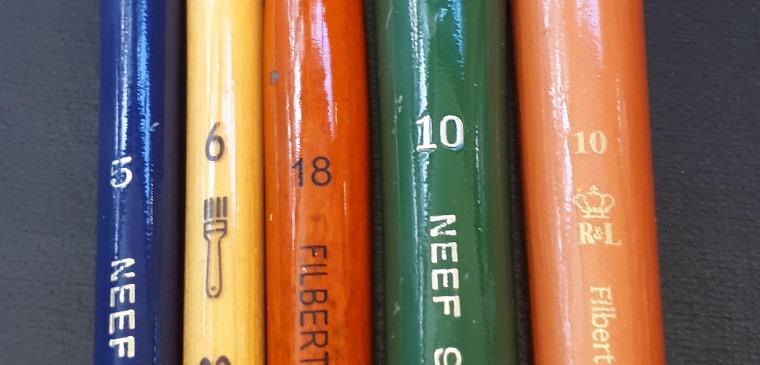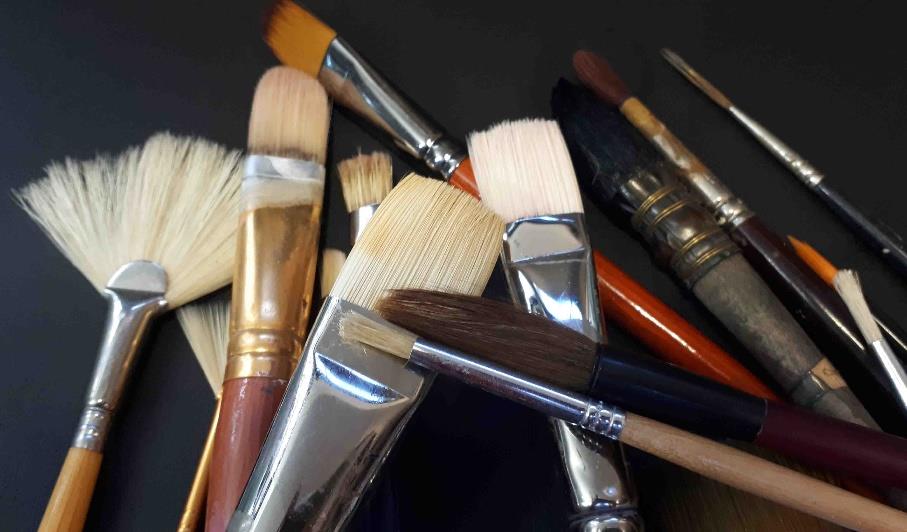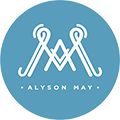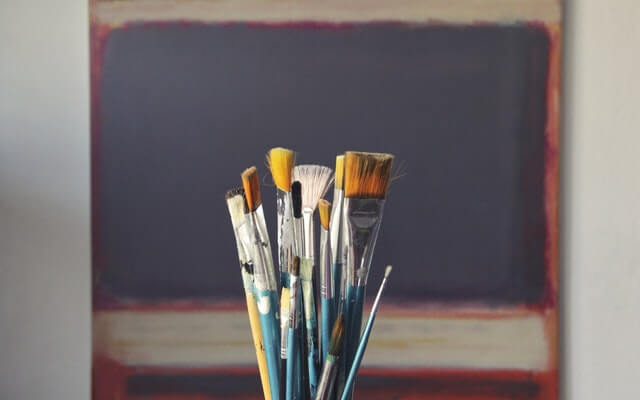
This is not a question that can be easily answered because it’s really a personal choice. Most things about art are personal choice. When it comes to brushes, honestly, I would say…learn a bit about them and then actually give them a try. There are different shapes, bristles and sizes. You need to find what works for you; the mark that it leaves; how it picks up the paint; and, how easily it cleans. By experimenting you’ll figure out for yourself what you like.
Birstles: Fluffy End Bit
The one thing I’d say is when trying different brushes think about the medium you are using, such as, watercolour, oil paints, acrylics etc. And start experimenting with the bristles that are commonly used for that particular medium. I’m not one for art rules but…there is a reason why certain brushes are advertised to be used with specific mediums. If you’re working with watercolours and/or inks, you really want a bristle – the end of the brush, the fluffy part – that to holds a lot of water. The reason why is because it’s the water that your pigment (colour) is suspended in.

Sable and synthetic round
So, if you use a brush that is quite dry (can’t hold a lot of liquid) then you’re not going to get much on your brush to paint with; to leave your mark with. You’re going to have to keep topping it up. Not that you can’t do that. I mean you could, theoretically, paint watercolours with a stick, cotton bud or leaf. It’s just that you wouldn’t get a lot of pigment on your brush to work with. So…that is one thing you will need to consider; which bristles are best for different mediums.
| Bristle | Oils | Acrylic | Watercolour/Ink |
|---|---|---|---|
| Sable (fur from a Sable, Squirrel or Weasel) Very Soft | ✔ | ||
| Hog Hair (hair from a boar) Course | ✔ | ✔ | |
| Camel Hair (hair from an ox, goat or pony) Med Soft | ✔ | ✔ | ✔ |
| Synthetics (made from fake stuff) Soft – firm | ✔ | ✔ | ✔ |
Bristles: Natural v’s Synthetic
NATURAL: Fur farming industry (animals are farmed and killed). Other, slightly more ethical (animals are hunted, trapped, and released).
SYNTHETIC: Laboratory – no animals just fake stuff.
Side note on fur industry: The animal is killed for its fur for other industries, not specifically art; however, the tail of the animal is a discarded part of the animal. Brush manufacturers use this part of the animal for their brush bristles.
On that note, because I am a bit of an ethical environmental freak, I recommend synthetics. I am usually all about natural fibres and organic materials; however, bristles that are best for watercolours and inks come from animals. You can get brushes with sable (it’s not usually actually sable anymore) that are ethically sourced. The animal is hunted in the wild, trapped and then released…after a few hairs have been taken from them. This is definitely a far more ethical process than, let’s say, the fur farming industry.

Mass production of brushes use the farming of animals specifically for their fur/hair. The animals usually have a single purpose and not a very long, nor natural, life-span. If this is of
a concern for you but you really like using natural bristles, then you can take the time to do research on which companies source their materials ethically. Otherwise, particularly while you are starting out and playing with different brushes, go synthetic.
You can buy cheap synthetic brushes that hold enough water so when working with watercolours you have enough pigment to play with and no animal was harmed in the making of it. This goes for oil and acrylic painting too. Commonly, natural animal fibres are used but there are really good synthetic alternatives.
When you’re working with oil paints, my favourite medium of all, you don’t want the oil paint to soak into the bristle. You want it sitting on top of the bristle. You want to be able to scoop it so you can lay it down on the canvas (or whatever your chosen surface is), and you can’t do that with really soft bristles. You can do it with course bristles, medium bristles, palette knives, sticks and other homemade painting implements. But you really don’t want to be using very, very soft, water purposed brushes.
That goes for acrylic paints too. Although acrylics are water soluble paints, you can make them quite thin and runny, if you want to use your acrylic paint thickly for some texture then you’ll want your brushes to be of a firmer bristle. That way, you can actually pickup the paint and lay it on your surface. You’ll get a layered-on surface look rather than a dyed surface look; like you would with watercolour. That’s just a few things to consider with brush bristles. I wouldn’t recommend exploring watercolours with a hog hair brush, or using sable brushes with oil paints. Keep in mind…I don’t like Art Rules, but I also don’t like making my creative exploration horrible and painful. Knowing your materials = more arty fun.
Brush Sizes: They aren’t standard
When it comes to the choice of brush sizes (0, 6, 20 etc), there is no industry standard. You could get a materials list from a tutor that asks for you to have a size 6, 8, 10 and 20 in your art arsenal but just going into a shop and buying that size may not result in you buying the intended size. So, you’ll need to just look at the size of the brush not rely on the size number.

If you are going into a class or workshop, ask your tutor for more details, such as, the brush dimension, not just the manufacturers assigned number. Take a tape measure into the art shop – the shop assistant has probably seen stranger things – and check the size before buying.
You also shouldn’t, I believe, feel like you have to spend a lot of money on your art kit for a class or workshop. Meaning…you don’t want to be restricted in buying the exact same brand as someone else. Let’s face it, we are unique creative creatures. I suggest trying different sizes. Get a couple small, a couple of medium and definitely a couple of large brushes to trial. Large brushes are great for blocking in and mapping paintings.
And, if you continue using a large brush throughout the painting you will have the advantage of not getting caught up in the detail too soon.
I wouldn’t start with a small brush because it makes me focus on the details and not the process of painting…which is a heck of a lot of fun – that’s when the music is really pumping and I’m burning calories. I can focus on the big shapes and large tonal areas, and making big marks. It gets that Arty Heart of mine invigorated and inspired. So, get a variety of brush sizes but don’t go overboard. At the most get 4-6 brushes in total, particularly to start with. Don’t have lots of everything. You don’t need it. It’s a waste of money and adds to the confusion as well.
Shapes: Body Positive

Another thing to consider is the shape. You can get round brushes, square brushes, fan brushes and filbert brushes; which are like square brushes but the edges are rounded off. And, once again, try them. You’d be surprised how round a mark you can make with a square brush or square mark with a round one. So, they’re not restricted to a specific purpose. No one brush is for just one thing. So, in that mix of brush sizes you’re going to get, also get a variety of shapes. Because you’re not going to know what you really like until you have a play with them.
Traditionally for watercolour and inks a rounded brush (some are known as a mop) because it holds a lot of pigment. However, I tend to use a synthetic square brush for my inks and watercolours. That’s probably because I am used to using that shape with my oil paintings. It is also because I like having straight edge brush strokes visible in my artwork. The variety is what’s going to help you refine what you like to use and how to use them.

